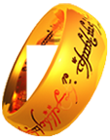Places in Middle-earth
Buckland
Type: Kingdoms, Realms, Lands
Region: Bree/The Shire
Other Names Eastmarch
Location: The region of the Shire between the Brandywine and the Old Forest; also called the Eastmarch; settled in 2340 Third Age by Stoors from the Marish.
Description:
2340
.... The Oldbucks occupy the Buckland.
The Lord of the Rings, Appendix B, The Tale of Years: The Third Age
Long ago Gorhendad Oldbuck, head of the Oldbuck family, one of the oldest in the Marish or indeed in the Shire, had crossed the river, 1 which was the original boundary of the land eastwards. He built (and excavated) Brandy Hall, changed his name to Brandybuck, and settled down to become master of what was virtually a small independent country. His family grew..., until Brandy Hall occupied the whole of the low hill.... The Brandybucks and their numerous dependants then began to burrow, and later to build, all round about. That was the origin of Buckland, a thickly inhabited strip between the river and the Old Forest, a sort of colony from the Shire. Its chief village was Bucklebury, clustering in the banks and slopes behind Brandy Hall.
The people in the Marish were friendly with the Bucklanders, and the authority of the Master of the Hall (as the head of the Brandybuck family was called) was still acknowledged by the farmers between Stock and Rushey. But most of the folk of the old Shire regarded the Bucklanders as peculiar, half foreigners as it were. Though, as a matter of fact, they were not very different from the other hobbits of the Four Farthings. Except in one point: they were fond of boats, and some of them could swim.
Their land was originally unprotected from the East; but on that side they had built a hedge: the High Hay.... It ran all the way from Brandywine Bridge, in a big loop curving away from the river, to Haysend (where the Withywindle flowed out of the Forest into the Brandywine): well over twenty miles from end to end. But, of course, it was not a complete protection. The Forest drew close to the hedge in many places. The Bucklanders kept their doors locked after dark, and that also was not usual in the Shire.
The Fellowship of the Ring, LoTR Book 1, Ch 5, A Conspiracy Unmasked
'[The Riders] could have reached here by now, of course, if they were not stopped at the North-gate, where the Hedge runs down to the river-bank, just this side of the Bridge. The gate-guards would not let them through by night, though they might break through. Even in the daylight they would try to keep them out... until they got a message through to the Master of the Hall.... But, of course, Buckland cannot resist a determined attack for long.'
The Fellowship of the Ring, LoTR Book 1, Ch 5, A Conspiracy Unmasked
The habit of building farmhouses and barns was said to have begun among the inhabitants of the Marish down by the Brandywine. The Hobbits of that quarter, the Eastfarthing, were rather large and heavy-legged, and they wore dwarf-boots in muddy weather. But they were well known to be Stoors 2 in a large part of their blood, as indeed was shown by the down that many grew on their chins.... Indeed, the folk of the Marish, and of Buckland, east of the River, which they afterwards occupied, came for the most part later into the Shire up from south-away; 3 and they still had many peculiar names and strange words not found elsewhere in the Shire.
The Lord of the Rings, Prologue, Concerning Hobbits
Notes
1 Brandywine. The hobbit-names of this river were alterations of the Elvish Baranduin (accented on and), derived from baran 'golden brown' and duin '(large) river'. Of Baranduin Brandywine seemed a natural corruption in modern times. Actually the older hobbit-name was Branda-nîn 'border-water', which would have been more closely rendered by Marchbourn; but by a jest that had become habitual, referring again to its colour, at this time the river was usually called Bralda-hîm 'heady ale'.
It must be observed, however, that when the Oldbucks (Zaragamba) changed their name to Brandybuck (Brandagamba), the first element meant 'borderland', and Marchbuck would have been nearer. Only a very bold hobbit would have ventured to call the Master of Buckland Braldagamba in his hearing.
The Lord of the Rings, Appendix F, The Languages and Peoples of the Third Age: On Translation
2 Except for the Masters of Buckland:
Even in Bilbo's time the strong Fallohidish strain could still be noted among the greater families, such as the Tooks and the Masters of Buckland.
The Lord of the Rings, Prologue, Concerning Hobbits
3 The Stoors lingered long by the banks of the Great River Anduin, and were less shy of Men. They came west after the Harfoots and followed the course of the Loudwater southwards; and there many of them long dwelt between Tharbad and the borders of Dunland before they moved north again.
The Lord of the Rings, Prologue, Concerning Hobbits
Contributors:
Lyllyn 7Mar04
Elena Tiriel 14Mar08
